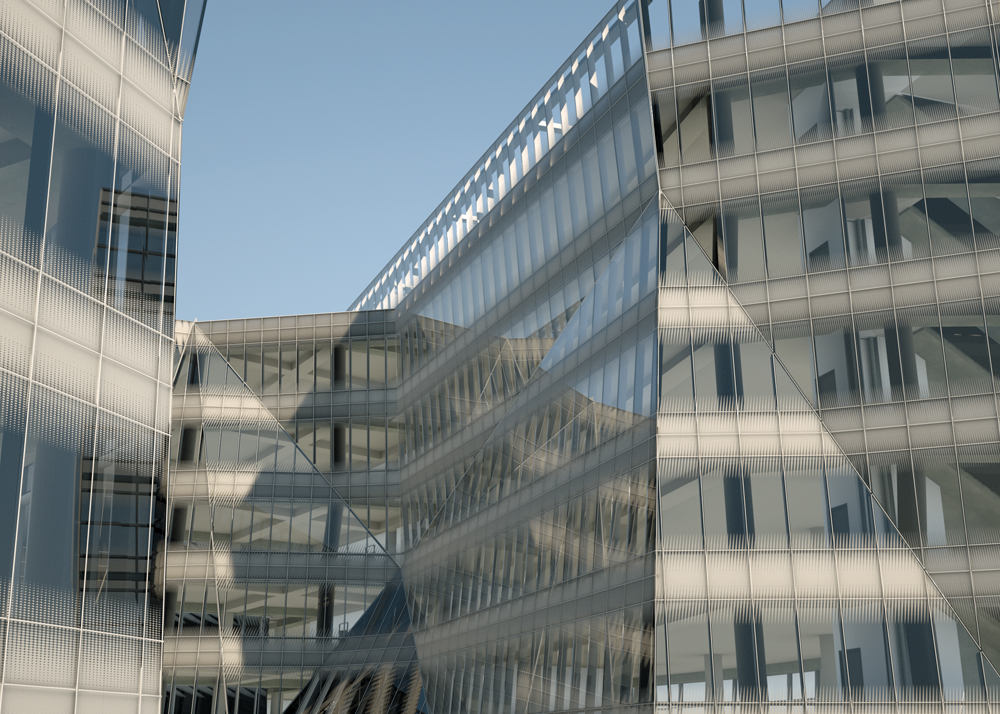Seven seconds. That is all it took for Gensler’s Mark Bassett to generate a geometrically accurate, photorealistic rendering from one of the firm’s Revit models. The colors popped. The lighting and shading were spot on. The materials, finishes, fixtures, and furnishings were precisely represented. There was no need for touch-ups using Photoshop, or tweaks in 3ds Max. Just a few clicks of the mouse and voilà!—a professional-level 3D rendering appeared on Bassett’s monitor.
Creating and refining renderings using traditional methods can be an arduous task, requiring several hours of work by a designer or thousands of dollars in outsourcing costs (and a 24-hour turnaround) to a rendering specialist. Bassett thought there had to be a better way.
A trained architect who is a whiz with computers, Bassett began his career as an architect and eventually transitioned to computer programming, joining the original Revit startup. Following the acquisition by Autodesk, he moved to the AEC side of the business, where he has spent the better part of the past decade helping Gensler integrate BIM tools and streamline project workflows using technology—in addition to practicing architecture.
One of his recent crusades is developing a simple process for creating high-quality renderings on the fly. The growth of BIM and 3D rendering technology, he says, has raised client expectations and placed additional pressure on the Building Team to produce visually striking artwork that accurately depicts the very latest iteration of a project’s design. No longer can renderings be simply representative of the design scheme. And turnaround time on artwork has to be in hours, not days or weeks.
“We’re getting to the point where even 24 hours isn’t fast enough,” says Bassett. “The deliverables are continuing to be requested at a faster speed.”
THE RISE OF GPU COMPUTING
To find a solution, Bassett turned to the gaming and moviemaking industries, where he learned of a newly developed software tool, called Octane Render, capable of processing photorealistic renderings 50 times faster than Gensler’s current methods.
Developed by Los Angeles-based cloud rendering company Otoy, Octane Render is part of a new breed of ultra-high-speed rendering applications that utilize GPU-accelerated computing methods popularized by the gaming industry. Instead of processing images using a computer’s CPU, Octane Render uses the machine’s graphics processing unit, together with the CPU, to greatly accelerate processing speeds. The results are dramatic, says Bassett.

By implementing Octane Render, Gensler has been able to reduce its render time to minutes versus hours. On the firm’s trial project with the software, architect Rosario Li Rocchi rendered the lobby of a government office project in just 10 minutes, including initial render creation, material selection, and final render output. Using the firm’s traditional methods (SketchUp and V-Ray), the same process took four hours. RENDERINGS: GENSLER
“To put it into perspective, when Pixar was developing the movie ‘Cars 2,’ its average rendering time per frame was 11.5 hours,” says Bassett. “We’re rendering at seven seconds a frame using Octane. It changes everything. There are now Hollywood movies being made using this technology.”
The results were as equally impressive on Gensler’s trial project with the software. Gensler architect Rosario Li Rocchi rendered the lobby design of a government office project in Washington, D.C.—first using the firm’s traditional process (export data from Revit into SketchUp for material and lighting assignments, and then render in V-Ray), then using Octane Render. The total production time was reduced from four hours to just 10 minutes. Best of all, says Bassett, Rocchi needed less than 10 minutes of one-on-one training to pick up the new software. For designers with little or no computer rendering experience, the learning curve is a bit steeper, but still less than a few hours, he says.
“The beauty of this software is that it’s extraordinarily easy to use,” says Bassett. “People who have never rendered before are producing acceptable results after just a couple hours of play.”
Gensler is the first U.S.-based AEC firm to implement the software program on a large scale. The firm owns 35 seats, and every office has at least one Octane-optimized workstation. At $250 a seat, the software is relatively affordable, and it doesn’t require a supercharged workstation to process renderings.
“Most of the new hardware we’re buying right now will run Octane,” says Bassett. “We have a few people with copies on their laptops, and they’re able to render at much faster speeds. Of course, with the optimized machines, the render speed is almost real time.”
TURNING ARCHITECTS INTO MOVIE DIRECTORS
Ultimately, Bassett sees Octane Render as a way for Gensler’s designers to add value to projects—not just through renderings, but also short movie clips of their design schemes. His goal: make it easy for designers unfamiliar with advanced rendering and character animation to create 30-second movie clips with camera and character animation in less than an hour.
Currently, animations are cost-prohibitive (running upwards of $15,000 in outsourcing costs for a well-executed 60-second clip), and the results are hardly ever impressive. “Animations are particularly problematic,” says Bassett. “We currently subcontract this work out, where a minute of ‘good’ quality video is still no match for Hollywood standards.”
This 23-second movie clip was produced by Gensler designers in about an hour using Octane Render. It is illuminated by sunlight, seven artificial lights, plus a light box wall with an illuminated image, all taxing on a renderer, according to Gensler's Mark Bassett.
To help his colleagues bring their designs to life through high-speed renderings and movie-like animations, Bassett wrote two custom scripts for Octane. The first is a Revit-to-Octane exporter that transfers all Revit geometry and materials directly into Octane, enabling near-real-time rendering creation straight from the BIM file.
The second runs within Octane and allows the software to render a series of frames directly from a BIM model, sequenced so that they can easily be turned into video using Windows Movie Maker. Bassett took cues from traditional moviemaking when writing this application. Instead of applying traditional computer graphics techniques found in most software tools, he modeled the script based on analogue camera manipulation techniques. As a result, users have the ability to move the camera through space, rotate and tilt from a single location, zoom in and out, and even clip scenes. Camera motion blur is also possible, as is animating the suns path through the sky.
“The user creates a series of compound camera moves—for example, zoom in while orbiting 90 degrees left—that are concatenated to make a movie,” says Bassett. “The sequence of moves can be saved to disk and reloaded for playback in Octane at a later date.” In this way, movie direction can precede the completion of the modeling activities, compressing the traditional critical path relationship between modeling and animation.

This façade rendering was generated straight from a Revit model in several minutes using Octane Render. Gensler is the first U.S.-based AEC firm to implement the software program on a large scale. The firm owns 35 seats, and every office has at least one Octane-optimized workstation. RENDERINGS: GENSLER
The final piece of the puzzle, which is still in the works, is assembling a library of Octane-ready animated assets (people, cars, trees, water, etc.) that can be dragged and dropped into movies to liven things up. These assets can be purchased commercially or produced in-house.
“It will enable staff to add motion to elements in the scene so that the video is not limited to wandering around a static model,” says Bassett. “It is this capability that differentiates the higher-end animations, and that adds significant additional cost.”
EARLY SUCCESS STORY
Jared Krieger, AIA, LEED AP, a Project Architect in Gensler's Washington, D.C., office, was one of the firm's first Octane users. He offers a story of how the software tool helped secure a new client:
"Speed and process are really important to our clients, especially when we get into larger global accounts. We were recently asked while competing for a relationship why it would be different to work with Gensler. In a meeting, we gave them a simulation of how we are starting to reinvent our process using Octane. We showed them how we can pan around the model while the computer almost simultaneously renders the view. And how we can make a tweak and quickly re-render almost seamlessly. They were turned on to the collaborative nature of the design process and our use of technology to assist. This was a huge win for us."
Related Stories
Adaptive Reuse | Jul 30, 2024
Empty mall to be converted to UCLA Research Park
UCLA recently acquired a former mall that it will convert into the UCLA Research Park that will house the California Institute for Immunology and Immunotherapy at UCLA and the UCLA Center for Quantum Science and Engineering, as well as programs across other disciplines. The 700,000-sf property, formerly the Westside Pavilion shopping mall, is two miles from the university’s main Westwood campus. Google, which previously leased part of the property, helped enable and support UCLA’s acquisition.
Geothermal Technology | Jul 29, 2024
Rochester, Minn., plans extensive geothermal network
The city of Rochester, Minn., home of the famed Mayo Clinic, is going big on geothermal networks. The city is constructing Thermal Energy Networks (TENs) that consist of ambient pipe loops connecting multiple buildings and delivering thermal heating and cooling energy via water-source heat pumps.
High-rise Construction | Jul 29, 2024
Safdie Architects’ Shanghai office tower features glass-enclosed corner garden that ascends the 35-story structure
Safdie Architects has announced the completion of LuOne Mixed-Use Complex—a business, retail, and entertainment development in the Luwan district of Shanghai, China. The mixed-use complex consists of an eight-level retail galleria, which opened in 2018, and a 35-story office tower, which recently reached completion.
Casinos | Jul 26, 2024
New luxury resort casino will be regional draw for Shreveport, Louisiana area
Live! Casino & Hotel Louisiana, the first land-based casino in the Shreveport-Bossier market, recently topped off. The $270+ project will serve as a regional destination for world-class gaming, dining, entertainment, and hotel amenities.
Smart Buildings | Jul 25, 2024
A Swiss startup devises an intelligent photovoltaic façade that tracks and moves with the sun
Zurich Soft Robotics says Solskin can reduce building energy consumption by up to 80% while producing up to 40% more electricity than comparable façade systems.
Codes and Standards | Jul 25, 2024
GSA and DOE select technologies to evaluate for commercial building decarbonization
The General Services Administration and the U.S. Department of Energy have selected 17 innovative building technologies to evaluate in real-world settings throughout GSA’s real estate portfolio.
Great Solutions | Jul 23, 2024
41 Great Solutions for architects, engineers, and contractors
AI ChatBots, ambient computing, floating MRIs, low-carbon cement, sunshine on demand, next-generation top-down construction. These and 35 other innovations make up our 2024 Great Solutions Report, which highlights fresh ideas and innovations from leading architecture, engineering, and construction firms.
Senior Living Design | Jul 23, 2024
The growing importance of cultural representation in senior living communities
Perkins Eastman architect Mwanzaa Brown reflects on the ties between architecture, interior design, and the history and heritage of a senior living community’s population.
MFPRO+ News | Jul 22, 2024
Miami luxury condominium tower will have more than 50,000 sf of amenities
Continuum Club & Residences, a new 32-story luxury condominium tower in the coveted North Bay Village of Miami will feature more than 50,000 sf of indoor and outdoor amenities. The program includes a waterfront restaurant, dining terraces with resident privileges, and a private dining room outdoor pavilion.
Healthcare Facilities | Jul 22, 2024
5 healthcare building sector trends for 2024-2025
Interactive patient care systems and trauma-informed design are among two emerging trends in the U.S. healthcare building sector, according to BD+C's 2024 Healthcare Annual Report (free download; short registration required).

















